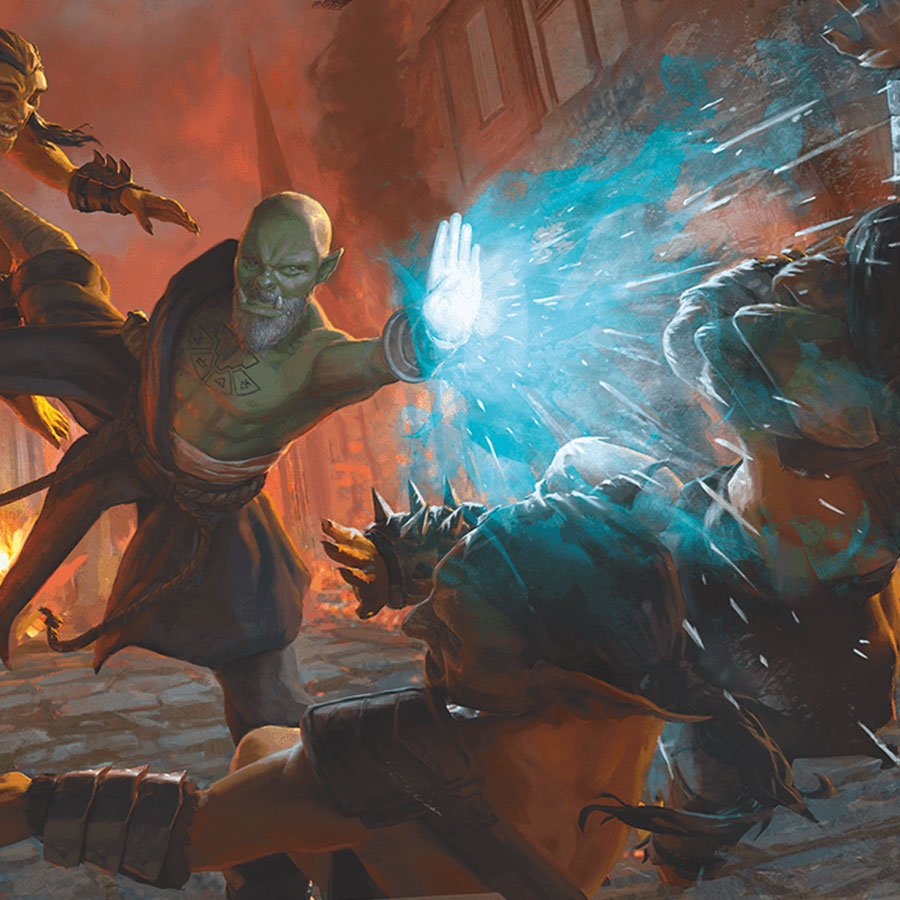How to Use Character Backstories in Pre-Written Adventure Modules

Written by Luke Hart
When game masters decide to run adventure modules, such as Curse of Strahd or Into the Fey, for their groups, I think it’s easy for us to scrap the notion of incorporating character backstories into the game because we may not be sure actually HOW to do that.
So, today we’re going to discuss three different ways you can build the backstories of your players’ characters into the game when you’re running a pre-made module or adventure path. We’ll go over the pros and cons of each approach, and touch on what types of groups each might be best for. Because, you know, not everything works for everyone.
And, as a reminder, just because you’re using an adventure module or adventure path, that doesn’t mean it includes everything that should be included in the game. As a game master you are free – encouraged even – to adjust things in the module as you see fit to customize it for the tastes and style of both you and your players – and that includes doing so to include backstory elements into the game.
Okay, here we go. Three ways to use backstories in pre-made adventure modules!
Watch or listen to this article by clicking the video below.
Place Backstory Elements into a Modules’ Existing Adventures
One simple way to incorporate character backstories into a pre-made adventure is to weave elements from those backstories into existing parts of the module. Rather than creating entirely new side quests or encounters, you can introduce small story beats that tie into a PC’s background. This method requires minimal alterations to the module, but it still allows players to feel like their character’s personal story is a part of the grand adventure.
Example:
Imagine one of your players has a character whose mentor bequeathed them a magical sword that was stolen by a thief. Instead of designing a new quest for the sword, you might decide that, during a regular encounter in the module, the party stumbles across the very sword the character has been searching for. Maybe it’s hidden in the loot of a defeated enemy, or perhaps it’s for sale in a mysterious shop the group passes through.
Or take Curse of Strahd as another example. Strahd is a manipulative villain, and you could have him tempt each PC based on their backstory. For instance, Strahd might offer a dwarf character a piece of his kingdom, tempt a power-hungry character with greater magical abilities, or promise to let another PC simply leave Barovia unscathed. By drawing on individual goals and motivations, you make Strahd’s influence more personal.
Pros:
- Minimal effort required from the GM (beyond a bit of creativity).
- Little to no impact on the core adventures in the module, so there’s no need to rewrite encounters or modify story beats.
- You can run the module as-is while still making the characters feel like their stories matter.
Cons:
- Since you’re not creating new content, there may be limitations on how much of a character’s backstory you can incorporate.
- It can feel less rewarding for players, as the connection to their backstory might be brief or surface-level.
- The backstory element could feel staged or forced, like the magical sword just happening to be in Barovia (although, with careful planning, you can avoid this).
Best for:
- Players who aren’t overly invested in roleplaying or deeply exploring their characters' motivations and simply want to play through the module.
- New GMs who want to run a module mostly as-is and don’t feel comfortable making significant adjustments. There’s nothing wrong with that approach, especially when you're still learning!
Place Backstory Elements into New Short-Form Content (Encounters)
If you’re looking to bring more depth to your game without going overboard, another approach is to create new, short-form content tied to a character’s backstory. This technique requires a bit more effort on the GM’s part, as you’ll need to design quick encounters or brief side quests that link directly to a player’s character. These mini-stories don’t need to be overly complex, but they should feel intentional and meaningful.
Example:
In one Curse of Strahd game, I had a player with a monk character. To tie into their backstory, I introduced another monk from the same monastery who had been sent to find the PC. This NPC offered to help the group as a sidekick, creating a brief yet impactful moment connected to the player’s past.
In another game, a player’s paladin character was haunted by revenants—undead soldiers he had killed long ago. These revenants showed up for a brief, tense encounter, challenging the paladin’s sense of honor and forcing him to face his past actions.
Pros:
- Medium effort for the GM, requiring more creativity but without the need for major game overhauls.
- Medium reward for the players, as these encounters feel personal and crafted just for them.
- Feels intentional and engaging but doesn’t come across as forced or overly convenient.
- Doesn’t disrupt the flow of the module by causing excessive leveling outside of the main content.
Cons:
- There aren’t too many downsides—this approach strikes a balance between effort and payoff.
Best for:
- GMs with some experience under their belt, or newer GMs willing to experiment and adapt to new challenges.
- Groups with players who enjoy exploring their characters’ backstories and love seeing those elements woven into the game, but still want to focus on the module’s core adventure.
Place Backstory Elements into New Long-Form Content (Adventures)
For GMs who love to create their own content, this method involves going all out by designing entire side quests or even full-length adventures based on your players’ backstories. These backstory-driven adventures can seamlessly fit into the module’s structure, providing a highly personalized experience for your group. This approach is more involved than the others but offers deep rewards for players and helps their characters’ stories come to life in significant ways.
Example:
While I don’t run a ton of pre-made modules, I’ve certainly created long-form adventures tied to character backstories. For instance, in my Sword Coast Guard game, one player’s character, Dalinor, had a history with a thieves guild called the Velvet Fists. I took that element from his backstory and built an entire adventure around it, allowing the group to delve into the politics and conflicts of the Velvet Fists.
On another occasion, during my Curse of Strahd campaign, the party wanted to find the Mad Mage. Instead of following the module’s original description of him wandering Barovia, I decided to create an adventure where they would explore the Tower of the Mad Wizard, adding an entirely new experience to the campaign.
Pros:
- High reward for players, as their characters’ personal stories take center stage for entire sections of the game.
- Feels intentional and immersive, giving the players a sense of deep involvement in the world.
Cons:
- High effort for the GM, as you’ll need to create full adventures (although for many GMs, this is actually a pro since designing new content is often a favorite part of the job).
- Adding large chunks of new content can draw out the module, and you may need to adjust the difficulty of the original adventures to compensate for the additional leveling up.
Best for:
- Experienced GMs who know how to adjust module difficulty and handle level scaling. You’ll need to balance extra content with the module’s existing structure. New GMs can certainly give this a try as well, but be prepared for some challenges. If you’re willing to roll with the punches, it can be an exciting way to stretch your GM muscles!
- Groups with players who love roleplaying and want to explore their characters' motivations, desires, and backstories. These players will embrace big detours from the module, and they’ll enjoy the extended gameplay—even if it means the campaign will take longer to complete.
100 Years of GM Experience at Your Fingertips!
Are you a NEW GAME MASTER feeling a bit overwhelmed by everything involved with running a role-playing game? Are you a VETERAN GAME MASTER looking for new tips and tricks to take your games to the next level? Look no further than the Secret Art of Game Mastery.
We at the DM Lair have distilled our CENTURY of accumulated GM experience into an easy-to-read guide of practical advice that you can immediately apply to your games! We've even included our own templates–the things that we use to prepare our ACTUAL games.
Get all three books to master your game:
- The Secret Art of Game Mastery. Contains over 100 years of GM advice distilled into an easy-to-read format. It introduces and explains the tools of the trade, scheduling, playstyle, post-game notes, getting player feedback, and more.
- The Secret Art of Preparation. Brings to your fingertips the actual templates and guides that the DM Lair team uses to prepare games, Lair Magazine, and more. Designed as a three-ring binder, it's intended for you to write directly into for your entire campaign!
- The Secret Art of Notetaking. Gives you the keys to tracking your campaign from session to session just like the DM Lair team. Designed as a three-ring binder, it's intended for you to write in and keep track of your whole campaign!
With so much knowledge and experience on its pages, The Secret Art of Game Mastery is guaranteed to become an indispensable tool for all game masters, new and veteran alike. And if that isn’t enough, the information applies to all game systems and all genres!
-
Posted in
Game Master How-To Articles







